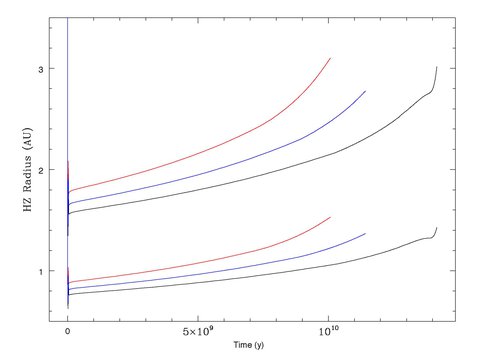2011 Annual Science Report
 Arizona State University
Reporting | SEP 2010 – AUG 2011
Arizona State University
Reporting | SEP 2010 – AUG 2011
Astrophysical Controls on the Elements of Life, Task 2: Model the Chemical and Dynamical Evolution of Massive Stars
Project Summary
The elemental ratios in stars and their planets will differ because each star has a different contributions from sources of stellar nucleosynthesis. The dominant contributions of heavy elements to molecular clouds come from supernova explosions, which may also contribute material just prior to star formation. To quantify what elements might be contributed by supernovae, in this task we first perform numerical simulations of stellar evolution, predicting how stellar properties (e.g., luminosity, temperature, internal composition, stellar winds, etc.) change over time. These results are made available to the public. We then simulate the explosions of massive stars as supernovae, to determine what elements are ejected. As a complementary study, we are also using spectra of stars, obtained during radial velocity planet searches, to find the chemical abundances of hundreds of nearby, potentially habitable stars, to assess the variability of starting compositions, and we are also modeling how the habitable zones of stars with these starting compositions might vary over time.
Project Progress
Massive stars are the primary sources of chemical elements necessary to planet formation and biology. Accurate physical descriptions of stellar evolution are required to predict nucleosynthetic yields. Patrick Young (ASU) and David Arnett (UofAZ) implemented the “321D” algorithm to model turbulent convection in stellar interiors in the TYCHO stellar evolution code. This treatment is unique. With Ray Sanders (ASU) we have made publically available a complete library of stellar evolution tracks from 0.6 to 100 solar masses for multiple chemical compositions through a web-based interface. Patrick Young, Carola Ellinger (ASU), Chris Fryer, and Gabe Rockefeller (Los Alamos) generated a large suite of 3D supernova simulations. We completed a code to post-process the thermodynamic histories of particles in the explosions to find detailed, spatially resolved nucleosynthetic yields.
The composition of stars strongly influences their evolution and properties of their planets. Patrick Young, Michael Pagano (ASU), Eric Mamajek (NOAO), and Eric Bubar (Marymount) have created a pipeline to extract chemical abundances for up to 26 elements from spectra of radial velocity planet search candidates. We have obtained >600 stars from Paul Butler (CIW) and have data for 100 young (<20 My old) stars in the Scorpius-Centaurus OB Association from our own Magellan telescope time. Analysis of existing abundances for >100 stars from Jade Bond (PSI) shows a factor of two spread in abundance ratios of common elements. Patrick Young and Kelley Liebst (ASU) are creating stellar models of habitable stars for these variable abundance ratios With TYCHO. We find substantial variations in the lifetime and extent of habitable zones for some compositions. Allen McNamara, Patrick Young, and Bryce Caradne (ASU) are using the long-lived radioactive isotope abundances inferred from the observations as initial conditions for parameterized convection models of planetary interiors to understand the thermal evolution of exoplanets with significantly different radioisotope inventories from earth.
Radii of the inner and outer edges of the habitable zone. Figure 1: The radii of the inner and outer edges of the habitable zone as a function of time for 1 solar mass stars with O/Fe of twice solar (black), standard (blue), and ½ solar. Habitable zone radii are estimated using the “50% cloud” criterion from Selsis et al. 2008. The length of time a given orbit will remain in the habitable zone can vary by gigayears near the edge of the zone.
Publications
- Ellinger, C.I., Young, P.A., Fryer, C.L. & Rockefeller, G. (2011). A case study of structure formation in simulations of the explosion of a 15 solar mass star. The Astrophysical Journal (in review).
-
PROJECT INVESTIGATORS:
-
PROJECT MEMBERS:
Allen McNamara
Co-Investigator
Francis Timmes
Co-Investigator
David Arnett
Collaborator
Eric Bubar
Collaborator
R. Paul Butler
Collaborator
Chris Fryer
Collaborator
Eric Mamajek
Collaborator
Gabriel Rockefeller
Collaborator
Bryce Carande
Graduate Student
Carola Ellinger
Graduate Student
Kelley Liebst
Graduate Student
Michael Pagano
Graduate Student
Raymond Sanders
Undergraduate Student
-
RELATED OBJECTIVES:
Objective 1.1
Formation and evolution of habitable planets.
Objective 3.1
Sources of prebiotic materials and catalysts

